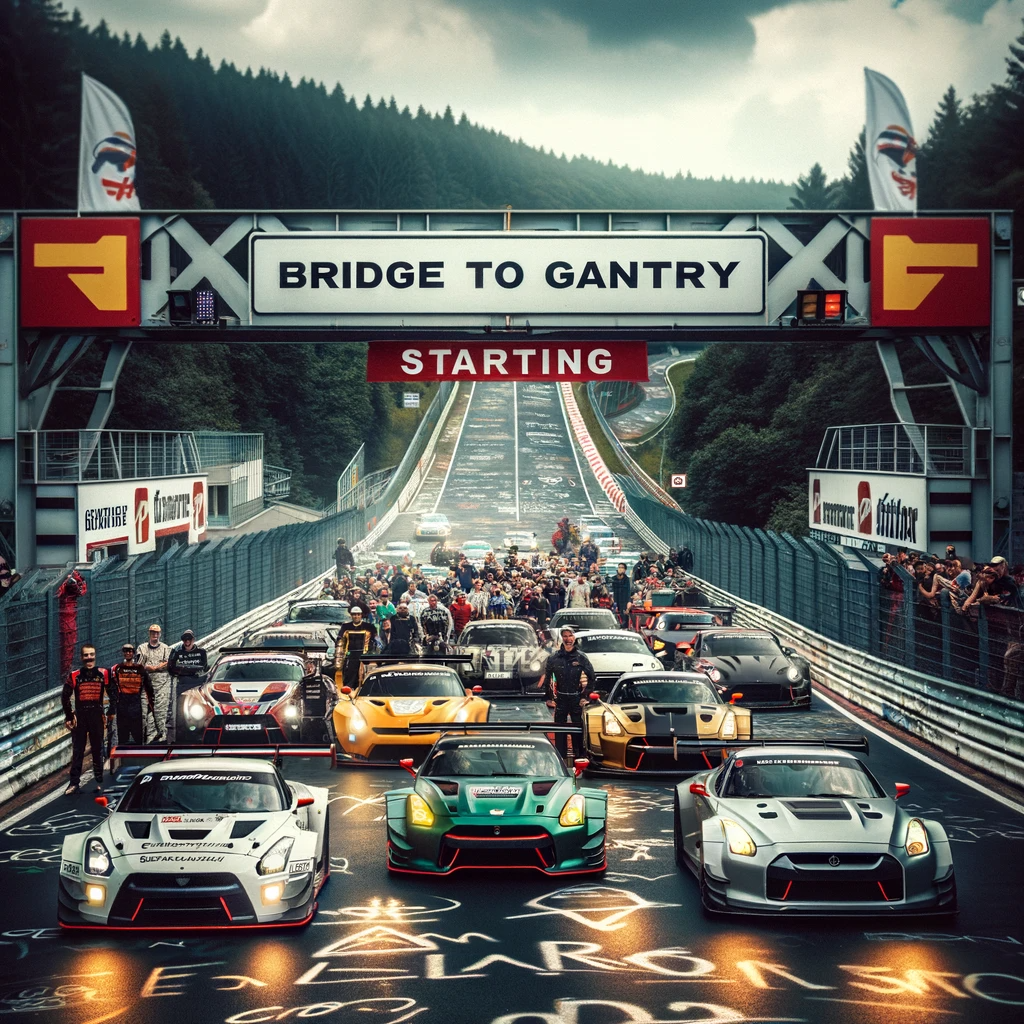

Welcome to the legendary Nordschleife, also known as "The Green Hell," a track that weaves through the Eifel Mountains in Nurburg, Germany. This site will provide a glimpse into the world of the Nordschleife, introducing the "Bridge to Gantry" lap which is a celebrated tradition amongst racing aficionados. Here, the Nordschleife is more than a track; it's an enduring testament to the spirit of motorsport, where each turn and straight tells a story of speed, skill, and splendor.
Born in the 1920s as a testing track and racing venue, the Nordschleife has hosted an array of prestigious events, including Formula One races until the mid-1970s. With 154 turns and 20.8 kilometers of winding asphalt, the track has rightfully earned its nickname, "The Green Hell," from racing legend Jackie Stewart. This section invites you to explore the track's inception, its golden years, and the developments that led to the iconic "Bridge to Gantry" timing.
The Nordschleife was originally built to alleviate unemployment in the Eifel region and quickly became a beacon for motorsport enthusiasts. Its early years saw it gaining popularity, not just for its challenging nature but also for the breathtaking scenery that accompanies the demanding track. However, its true test came with the advent of Formula One, where the track's narrowness and lack of runoff areas posed significant challenges and dangers.
In 1961, the Nordschleife witnessed one of its most notable events when driver Wolfgang von Trips collided with another car, leading to a tragic accident. This and other incidents led to increased safety measures and, eventually, the halting of Formula One races at the Nordschleife in 1976. However, the track continued to evolve, hosting other racing events and becoming a crucial testbed for automotive development.
The "Bridge to Gantry" lap emerged as a way for both professional drivers and enthusiasts to measure their prowess on a significant but manageable portion of the track. This segment, running from the bridge at the start of the track to the gantry near the end, excludes the longest straight of the circuit, known as the "Döttinger Höhe" straight. It became a popular way to gauge performance because it offered a mix of technical corners, elevation changes, and high-speed sections, encapsulating the essence of the Nordschleife experience.
Today, the "Bridge to Gantry" is not just a timing method; it's a tradition, a bucket-list item for many, and a shared experience that connects drivers from around the world. It symbolizes not just the history of the Nordschleife but also the ongoing passion and respect for this legendary track. As you read on, you'll discover the stories, the cars, and the people that have made the Nordschleife and the "Bridge to Gantry" what they are today: icons of the motorsport world.
The Nordschleife is known for its diverse and challenging forms of lap timing, each offering a unique way to measure performance and skill. The full lap of the Nordschleife, bypassing the modern GP track, stretches over 20,832 meters (12.944 miles). However, for safety reasons, most laps are completed 200 meters (656 feet) shorter. Full uninterrupted flying laps, capturing the entire essence of the track, are exclusively reserved for closed sessions and race events, where professionals push the boundaries of speed and endurance.
During tourist driving sessions, the "Bridge to Gantry" timing is commonly used due to the exit/entrance on the main straight, which prohibits driving at full speed. This method measures a 19.1 km (11.9 mi) lap from the "bridge" at Antoniusbuche to the "gantry" (often carrying sponsorship, like Audi) on Döttinger Höhe. It's a popular way for enthusiasts and semi-professionals to test their mettle, offering a mix of technical challenges and high-speed sections that encapsulate the Nordschleife experience.
Many record-setting laps have solidified the Nordschleife's status as a performance benchmark. From production marvels to modified titans, each form of timing - be it the full lap or "Bridge to Gantry" - serves as a testament to automotive and human potential. Discover the fastest times across various categories, including production, prototype, and electric vehicles. Witness how advancements in technology and driving skill have continuously redefined what's possible on this demanding track.
These records are not just numbers; they are stories of innovation, determination, and a relentless pursuit of excellence. Each lap time tells a tale of a driver and their machine working in perfect harmony, conquering the 'Green Hell' one turn at a time. As you explore this section, immerse yourself in the history and heroics of those who've left their mark on the Nordschleife, setting benchmarks that inspire and challenge future generations.
The following are some of the notable lap times recorded at the Nürburgring for production/street-legal vehicles:
Other notable entries include vehicles from Porsche, Lamborghini, and Radical, among others, all of which have attempted and set impressive times on the Nürburgring track.
These records highlight the advanced engineering and performance capabilities of modern production vehicles. Each record-setting lap is a testament to the vehicle's design, power, and the skill of the driver, offering insights into what these street-legal machines can achieve under optimal conditions.
Bridge to gantry (BTG) times are a popular way for drivers to measure and compare performance. The following are some of the notable BTG lap times recorded:
These times are indicative of the vehicles' engineering, the drivers' skill, and the tire technology. Each BTG time is a testament to what these machines can achieve under nearly optimal conditions, offering a glimpse into the capabilities of modern performance vehicles on one of the most challenging tracks in the world.
The Nordschleife has been a silent witness to a cavalcade of significant events that have shaped the world of motorsport. This section will recount those unforgettable moments, from nail-biting races to heart-wrenching tragedies. Learn about the events that have made the Nordschleife much more than a track - a crucible where legends are forged and tales of valor and skill are etched into the annals of history.
Discover the stories behind the most iconic races, the technological breakthroughs tested on its curves, and the human spirit's unyielding pursuit of pushing past the possible. This track isn't just about the cars; it's about the people who drive them and the dreams that drive the people.
In the 1920s, the Nürburgring Nordschleife became the proud host of the German Grand Prix, marking its significance on the global motorsports stage. This era solidified the track's reputation as a challenging and prestigious venue for racers and manufacturers alike.
For decades, the Nordschleife was a regular fixture in the Formula One World Championship, attracting the world's best drivers. Its treacherous layout and demanding nature tested the limits of driver skill and vehicle performance, contributing to its nickname 'The Green Hell'.
The inaugural 24 Hours of Nürburgring race in 1970 began a tradition that continues to this day. This endurance race tests the durability and performance of vehicles and drivers, becoming a celebrated event in the racing calendar.
The 1976 German Grand Prix witnessed a horrific accident involving Niki Lauda, which nearly claimed his life. The event led to significant safety reforms and discussions about the appropriateness of Formula One races on such a demanding track, eventually leading to the removal of F1 races from the Nordschleife.
In 1983, German racing driver Stefan Bellof set a record-breaking lap time of 6:11.13 in the Porsche 956 at the Nordschleife during the 1000km of Nürburgring race. Observers were particularly astounded as Bellof maintained full acceleration through a challenging section of the track, which was later named the 'Bellof S' in his honor. This remarkable maneuver highlighted his extraordinary skill and courage, etching this lap into the annals of racing history as a legendary feat and also demonstrated the technological prowess of the era's racing machines.
In 1983, German racing driver Stefan Bellof set a record-breaking lap time of 6:11.13 in the Porsche 956 at the Nordschleife during the 1000km of Nürburgring race. Observers were particularly astounded as Bellof maintained full acceleration through a challenging section of the track, which was later named the 'Bellof S' in his honor. Beyond his achievements at the Nordschleife, Bellof had a promising Formula 1 career. Tragically, his life and career were cut short in 1985 when he was involved in a fatal accident during a World Sportscar Championship race at Spa.
Since the 1980s, the Nordschleife has become synonymous with lap records, as manufacturers and teams use the demanding circuit to showcase their vehicles' capabilities. This era underscores the continuous advancements in automotive technology and engineering.
Sabine Schmitz, famously known as the "Queen of the Nürburgring," was a renowned German racing driver and television personality. With an intimate knowledge of the track, Schmitz claimed to have completed over 20,000 laps around the Nordschleife. She gained international fame for her appearances on the television show Top Gear, where she showcased her exceptional driving skills. Schmitz's achievements at the Nürburgring, her vibrant personality, and her advocacy for women in motorsport left an indelible mark on the racing world. A section of the Nürburgring Nordschleife was renamed "Sabine-Schmitz-Kurve" in her honour.
The Nürburgring Nordschleife continues to host a variety of motorsport events, including touring car races and endurance challenges. Additionally, it serves as an essential testing ground for automotive companies, setting the benchmark for performance and reliability in the industry.
Step into the world of the Nordschleife itself, a track that is as beautiful as it is brutal. This section will guide you through every twist, turn, and straight of the 20.8 kilometers that have challenged the very best in the world. Learn about the infamous sections like "Caracciola Karussell" and "Schwedenkreuz," where the track not only tests the cars but also the courage and skill of those behind the wheel.
Understand the intricacies of its design, the elevation changes that can unsettle the most balanced cars, and the unpredictable weather that can turn a race on its head. The Nordschleife is a masterclass in complexity and challenge, a track that continues to be the ultimate benchmark for both man and machine.
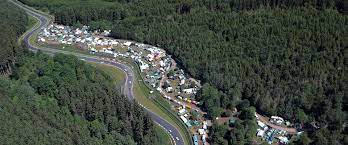
The Hatzenbach Complex is a series of tight and twisting bends early in the lap, demanding skillful steering and throttle control. This section tests the driver's ability to maintain rhythm and speed through rapid directional changes.

Hocheichen is a challenging right-hander followed by a quick descent. It's significant for its high-speed approach and sudden elevation change, crucial for maintaining momentum.
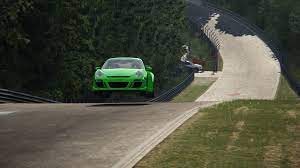
Flugplatz, meaning 'airfield' in German, is famous for cars getting airborne over its crest, combining high speeds and sudden lift-off to create a unique challenge.

Schwedenkreuz is one of the fastest and most dangerous sections, known for its high-speed approach and sharp, blind crest, requiring precise navigation.

Aremberg is a fast right-hand turn leading into a downhill section, notable for its harsh braking zone and being the entrance to the Fuchsröhre, balancing speed with control.
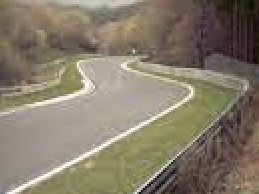
Fuchsröhre, or 'Foxhole', is a high-speed downhill section renowned for its compression at the bottom, testing both the car's stability and the driver's courage as they navigate the rapid descent.
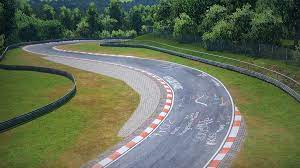
Adenauer Forst is a series of tight, technical turns following a high-speed straight, known for catching out even the most experienced drivers with its sudden change in pace and direction.

Metzgesfeld is a series of bends requiring precise steering inputs and a clear understanding of the car's dynamics, notable for its balance between speed and control.
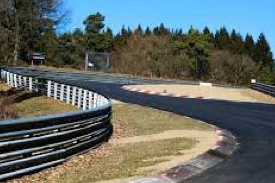
Kallenhard is a challenging section with a series of bends and a steep descent, known for its demand on drivers' focus and the need for precise braking and cornering.
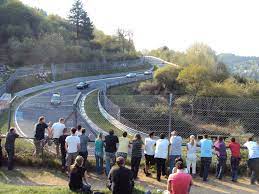
Wehrseifen is a steep downhill section leading into a sharp right-hander, renowned for its difficulty in braking and the skill required to maintain control while descending rapidly.

Ex-Mühle is a challenging uphill right-hand bend, known for its steep incline and the precision required to maintain speed while navigating the curve effectively.
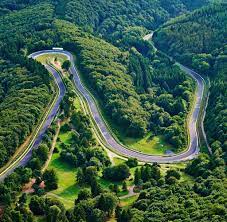
Bergwerk, or 'Mine', is a critical corner historically associated with Niki Lauda's near-fatal crash in 1976, demanding respect for its tight angle and the importance of a good exit speed.
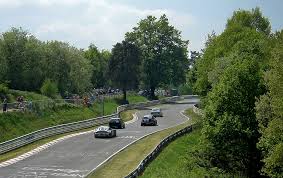
Klostertal is a downhill section leading into the infamous Karussell, requiring drivers to manage their speed and positioning carefully to set up for the next challenging part.

Steilstrecke, meaning 'Steep Stretch', is a rarely used section known for its extreme gradient, testing the limits of cars' and drivers' abilities to handle inclines.

Karussell is one of the most iconic sections of the Nürburgring, a banked concrete turn demanding precise entry and a strong stomach to maintain speed and position through its bumpy surface.

Hohe Acht, named after the highest point in the region, is a steep uphill section leading to a tight corner, challenging drivers with its elevation changes and tight bend.
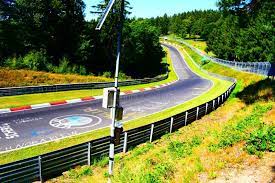
Wippermann is an undulating, fast section that tests drivers' skill and nerve as they navigate through quick bends at high speeds, often catching air.

Eschbach is a brief but crucial bend before the Brünnchen, requiring precise braking and steering to maintain speed and positioning for the upcoming sections.
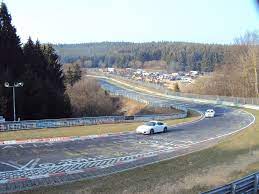
Brünnchen, known as 'the crowd's favorite', is a series of bends where spectators often gather to watch cars tackle one of the track's most engaging sections.

Pflanzgarten features a series of jumps and fast bends, presenting a thrilling challenge as drivers navigate its complex layout at high speeds.
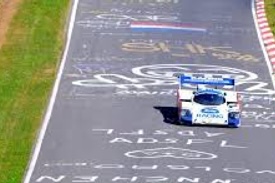
Stefan-Bellof-S is named after the legendary driver who set an astonishing lap record. This section is characterized by its demanding series of curves, requiring maximum precision and bravery.
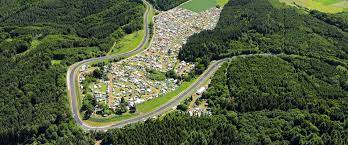
Schwalbenschwanz, or 'Swallow's Tail', is a distinctive series of curves resembling a bird's tail, challenging drivers with its rapid directional changes and sharp bends.
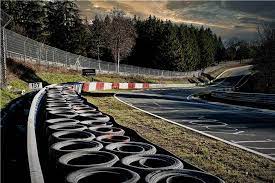
Galgenkopf is a crucial high-speed corner leading onto the long Döttinger Höhe straight, where drivers can set up for overtakes or prepare for a fast lap finish.
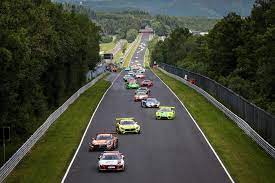
Döttinger Höhe is the longest straight on the Nürburgring, where vehicles reach their top speeds, offering a brief respite from the technical demands of the rest of the track.
"Touristenfahrten," or Tourist Days, are when the hallowed tarmac of the Nordschleife opens to the public, offering a taste of the legend to all. This section will tell you everything you need to know about these special days. Understand the thrill of driving your own vehicle on the same ground where history has been made, feeling every bump and curve that has challenged the greatest drivers in the world.
Learn about the rules, the culture, and the community that comes together during these days. Whether you're a seasoned racer or an enthusiast taking your first lap, Tourist Days are your portal into the world of the Nordschleife, an opportunity to make your mark on this legendary track.
Strict adherence to driving etiquette and safety regulations, mandatory wearing of helmets, and ensuring your vehicle meets technical standards.
Cars must be street-legal and cannot include non-road-legal safety features. Allowed: standard safety belts, factory roll cages, and street-legal tires. Not allowed: racing slicks, non-DOT-approved modifications, and professional racing harnesses without proper registration.
To join the Nürburgring Tourist Days, your vehicle must adhere to German Road Vehicle Registration standards. In simpler terms, it should be safe, capable of at least 60 km/h, and not exceed a weight of 2.8 tons. Avoid modifications like full 'winged' bucket seats, non-standard steering wheels, unpadded cages, or excessive aerodynamic additions. Quad bikes, trikes, karts, and certain number plates are also not permitted. It's all about ensuring everyone's safety and enjoyment on the track!
The marshalls are generally leniant and won't stop you so long as your car looks reasonably safe and road legal. For example, it's rare for cars to be stopped due to the use of racing seat belts or unpadded roll cages and it's quite common to see vehicles that exceed the 2.8 ton weight limit.
Newcomers might be taken aback to learn that 'winged' bucket seats and protruding towing eyes are strictly off-limits. This is especially unexpected for those accustomed to regular track days. Additionally, the use of slick tyres is also a no-go.
A respectful and supportive environment where enthusiasts share knowledge, experiences, and a mutual love for motorsports.
Sessions are usually open-ended, with drivers entering and exiting the track at designated points; overtaking is typically allowed on the left only.
Buy your lap ticket/pass, go to a safety briefing (only required if you're renting a track car), get your car ready for inspection, and then line up for your turn on the circuit. At the automated gates, scan your track pass and then hit the gas.
Bridge to Gantry is a segment of the Nordschleife that has become a benchmark for drivers around the world. It has become a revered challenge.
Bridge to Gantry is more than just a timing method; it's a community, a shared experience that connects drivers from diverse backgrounds with a common goal - to conquer the "Green Hell." There are many tales of triumph, frustration, near misses, spectacular crashes and above all the camaraderie, and the respect that the "Bridge to Gantry" invokes among all who take on its challenge.
Bridge to Gantry has become revered due to its ability to offer a real-world benchmark for drivers and vehicles alike. It's a challenging segment that tests skill, speed, and endurance, reflecting a driver's ability to handle one of the most demanding tracks in the world. Its popularity is also due to its accessibility for amateurs and professionals alike, allowing anyone to measure their performance against the best, creating a universal standard and a shared goal within the racing community.